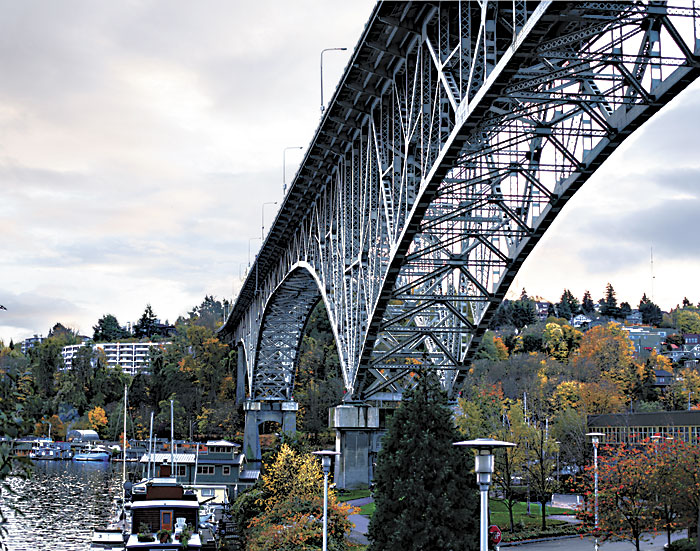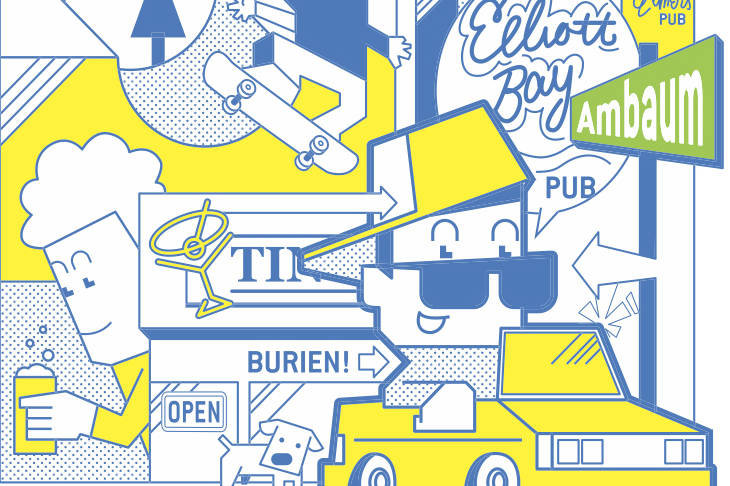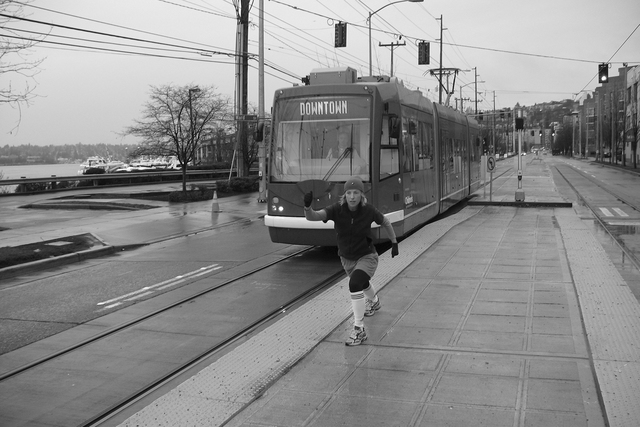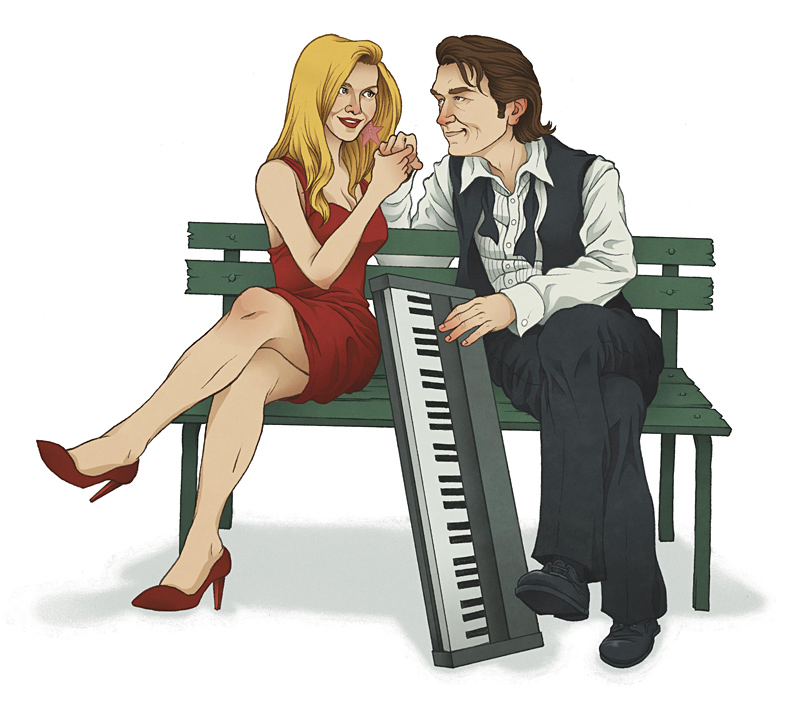On November 3, the day before many Americans experienced a reinvigorated sense of optimism, Derik Loso leapt from the Aurora Bridge during morning rush hour. To try to prevent fatalities like Loso’s, state officials plan to erect steel “suicide walls” nearly nine feet in height, which could be constructed as early as 2010 if two remaining political hurdles are cleared by the end of the 2009 state legislative session.
But the question many continue to ask is this: Why is the bridge—which ranks as the nation’s second-most popular suicide magnet, trailing only the Golden Gate Bridge, for which suicide netting was recently approved—even open to pedestrians in the first place? After all, anyone who needs to cross the canal on foot can use the Fremont Bridge. The answer pits quality of life versus life itself, and the proposed barriers represent a far thornier compromise than people have been led to believe.
In 2006, nine people committed suicide by jumping off the Aurora Bridge, which is officially named the George Washington Bridge and is a federally-registered historic landmark. That tally tied the 1972 fatality total as the highest in the bridge’s then-75-year history. In response, a group of Fremont merchants and residents, many of whom had witnessed the bodies landing, banded together to form Seattle FRIENDS (Fremont Individuals & Employees Nonprofit to Decrease Suicides).
Seattle FRIENDS’ initial proposal was simple: Close the bridge to pedestrians, bicycles, and all other non-motorized traffic. Residents on the southern end of the bridge, from the Queen Anne Community Council, suggested a caged walkway beneath the bridge deck as an alternative.
But what seemed like a slam-dunk solution to the problem was swiftly quashed by the city, bicycle advocacy groups, and the Washington State Department of Transportation, which has jurisdiction over the highway that includes the gorgeous yet treacherous span.
“We actually proposed that idea [of closing the bridge to non-vehicular traffic], but philosophically, WSDOT knew they’d have opposition from all the bicycle groups,” says Ryan Thurston, a Seattle FRIENDS spokesperson who lives and works in Fremont.
This response is echoed by Queen Anne Community Council chair Ellen Monrad. “That [i.e., why pedestrians are allowed on the bridge] was the first question that was asked, and we were told that it was a policy of the state of Washington that it has to be pedestrian-accessible,” says Monrad. “The solution would be to widen the [car] lanes, because it’s so narrow, and have [pedestrians and cyclists] go down to Fremont. I don’t know why they don’t do that.” (WSDOT spokesperson Greg Phipps confirms that the city and state are united in their philosophy that the span should remain open to pedestrians and cyclists, and WSDOT considers the caged walkways to be too expensive and hazardous.)
State Rep. Mary Lou Dickerson (D-Ballard), who was also involved in meetings concerning the bridge, recalls the same knee-jerk sentiment. “I asked [WSDOT] about [closing the bridge to pedestrians] a couple years ago, and their response was it was used quite a bit by bikers, and the biking community was dead set against removal.”
She’s right: They are. “The percentage of people who walk or bike across [the bridge] is much higher than the amount of people who jump,” says David Janis, executive director of the Bicycle Alliance of Washington. “Granted, there are ways below the bridge in Fremont, but I know some people who live in Queen Anne who take the bridge heading north and south. I think it’s an important corridor for bicycles.”
Cascade Bicycle Club advocacy director David Hiller is less measured in his take on the matter. “It’s a public right of way, and for a lot of people, it’s the shortest distance between point A and point B,” he says. “We’ve followed 50 years of an approach to transportation in this country that stole mobility from the 37 percent of people who don’t drive. So our basic policy is one of restoring connections, not severing them.
“If people want to commit suicide, they’re going to find a bridge to jump off,” continues Hiller. “The Aurora Bridge just happens to be a rather attractive one located next to a large homeless community in a greenbelt. It’s not the fault of having the bridge open to people. When people jump off I-5 or the Tacoma Narrows Bridge, they just need a car to get there.”
There’s no disputing the technical accuracy of Hiller’s final point. But a bridge isn’t a bridge isn’t a bridge, for two reasons: (1) pedestrian access and (2) iconography. As for the former, while the Aurora Bridge averages six suicides per year, I-5’s Ship Canal Bridge, which is closed to non-vehicular traffic, averages but one. As for the latter, UC Berkeley psychology professor Dr. Richard Stein found that of 515 people who were convinced not to carry out their plans to jump from the Golden Gate Bridge, only six percent attempted suicide again. There’s a dramatic element to the act, Stein’s study suggests; a leap off, say, Beacon Hill’s Jose Rizal Bridge just wouldn’t cut it for most would-be jumpers.
To be fair, Hiller acknowledges that the Aurora Bridge is a less-than-ideal path for cyclists, although he still considers it a critical two-wheel thoroughfare that he occasionally utilizes himself. Thurston, meanwhile, finds it downright scary. “I almost got blown off by a semi passing the other way,” he says, before estimating that “10 to one, bikers use Fremont” below, where Dexter Avenue ranks among the city’s most popular routes for bicycle commuters heading downtown.
Nick Licata, who co-chairs the Seattle City Council’s pedestrian safety committee, was actually stuck in the traffic jam caused by the police department’s efforts to talk Loso down from his fatal leap last Monday. Licata says he’s heard a fair amount of sentiment that the bridge should be closed to pedestrians, but feels that’s too drastic a step.
“To me, it just seems like a real primitive response—like if you have a toothache, just pull it rather than getting it filled,” says Licata. “I’ve been on the Golden Gate Bridge walking, and it was a great experience. I’ve actually never walked across the Aurora Bridge, but I’d like to. I think putting up a barrier is a responsible thing to do.”
Last year, WSDOT received $1.5 million from the state legislature to complete design work on the barriers. Because the bridge is a landmark, one of three final designs must be approved by the city’s Landmarks Preservation Board before the legislature can address whether to approve an additional $6 million in construction costs, a $7.5 million cumulative tab that QACC Chair Monrad isn’t sure is worth the cost.
“The people I talk to on Queen Anne are not sure that it’s necessary for the expense,” she says. “It’s a tragedy when people jump off the bridge, but [the barrier] is a deterrent, not a preventer. It isn’t going to be high enough; people who are determined can get over it.”
However, counters Don Kuch of the Crisis Clinic, “evidence indicates that barriers do work.” To wit, in Washington, D.C., home of two popular suicide bridges, the Taft and the Duke Ellington, when barriers were installed on one bridge, suicides on the other did not increase.
“People don’t simply change methods and kill themselves in other ways if they’re faced with interruption of their chosen means,” says Kuch, whose organization can be reached through several emergency call boxes that were installed on the bridge in response to 2006’s record carnage. “We’ll have stopped the moment of decision and delayed it, because people most often choose to seek support instead of a second means of suicide.
“Would closing the bridge [to pedestrians and bicyclists] be effective? Probably yes,” he adds. “Would putting up barriers be effective? Probably yes. Would people find a way to defeat those barriers? Probably yes.”








